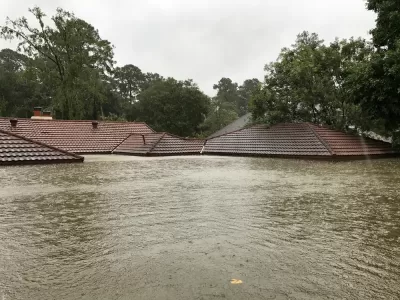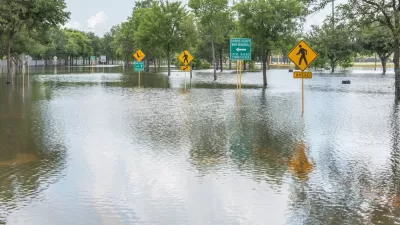Advocates and researchers say new development regulations, with more stringent flood protections, aren't doing enough to control the stormwater impacts of sprawl.

"As new development regulations in Houston attempt to offset the effects of more frequent heavy storms, some advocates and researchers say targeting the area’s urban sprawl will do more to reduce those at risk than limiting the amount of development in the city’s core," reports Emma Whalen.
The new regulations include "adjustments to flood plain boundaries, higher elevation requirements within flood plains and more significant detention requirements outside of flood plains," according to Whalen. The city has approved "25 drainage permits, many of which are subject to stricter city requirements," in and around the flood plains of Buffalo and White Oak Bayous since Hurricane Harvey, according to Whalen.
Meanwhile, development sprawl continues to sprawl beyond Houston's boundaries, raising concerns among advocates at the Bayou Preservation Association and academics at Rice University. Whalen summarizes the case for urban infill as an effective flood prevention tool:
Researchers, including Shelton, said approaching development regulations from a watershed level rather than a jurisdictional level would make it easier to manage stormwater runoff across Houston and its suburbs and would reduce the strain downstream on bayous and tributaries. This approach also calls for more dense development on existing property rather than converting open land into new subdivisions.
FULL STORY: In Houston, development must think outside the flood plains, advocates say

Alabama: Trump Terminates Settlements for Black Communities Harmed By Raw Sewage
Trump deemed the landmark civil rights agreement “illegal DEI and environmental justice policy.”

Planetizen Federal Action Tracker
A weekly monitor of how Trump’s orders and actions are impacting planners and planning in America.

The 120 Year Old Tiny Home Villages That Sheltered San Francisco’s Earthquake Refugees
More than a century ago, San Francisco mobilized to house thousands of residents displaced by the 1906 earthquake. Could their strategy offer a model for the present?

In Both Crashes and Crime, Public Transportation is Far Safer than Driving
Contrary to popular assumptions, public transportation has far lower crash and crime rates than automobile travel. For safer communities, improve and encourage transit travel.

Report: Zoning Reforms Should Complement Nashville’s Ambitious Transit Plan
Without reform, restrictive zoning codes will limit the impact of the city’s planned transit expansion and could exclude some of the residents who depend on transit the most.

Judge Orders Release of Frozen IRA, IIJA Funding
The decision is a victory for environmental groups who charged that freezing funds for critical infrastructure and disaster response programs caused “real and irreparable harm” to communities.
Urban Design for Planners 1: Software Tools
This six-course series explores essential urban design concepts using open source software and equips planners with the tools they need to participate fully in the urban design process.
Planning for Universal Design
Learn the tools for implementing Universal Design in planning regulations.
Clanton & Associates, Inc.
Jessamine County Fiscal Court
Institute for Housing and Urban Development Studies (IHS)
City of Grandview
Harvard GSD Executive Education
Toledo-Lucas County Plan Commissions
Salt Lake City
NYU Wagner Graduate School of Public Service





























